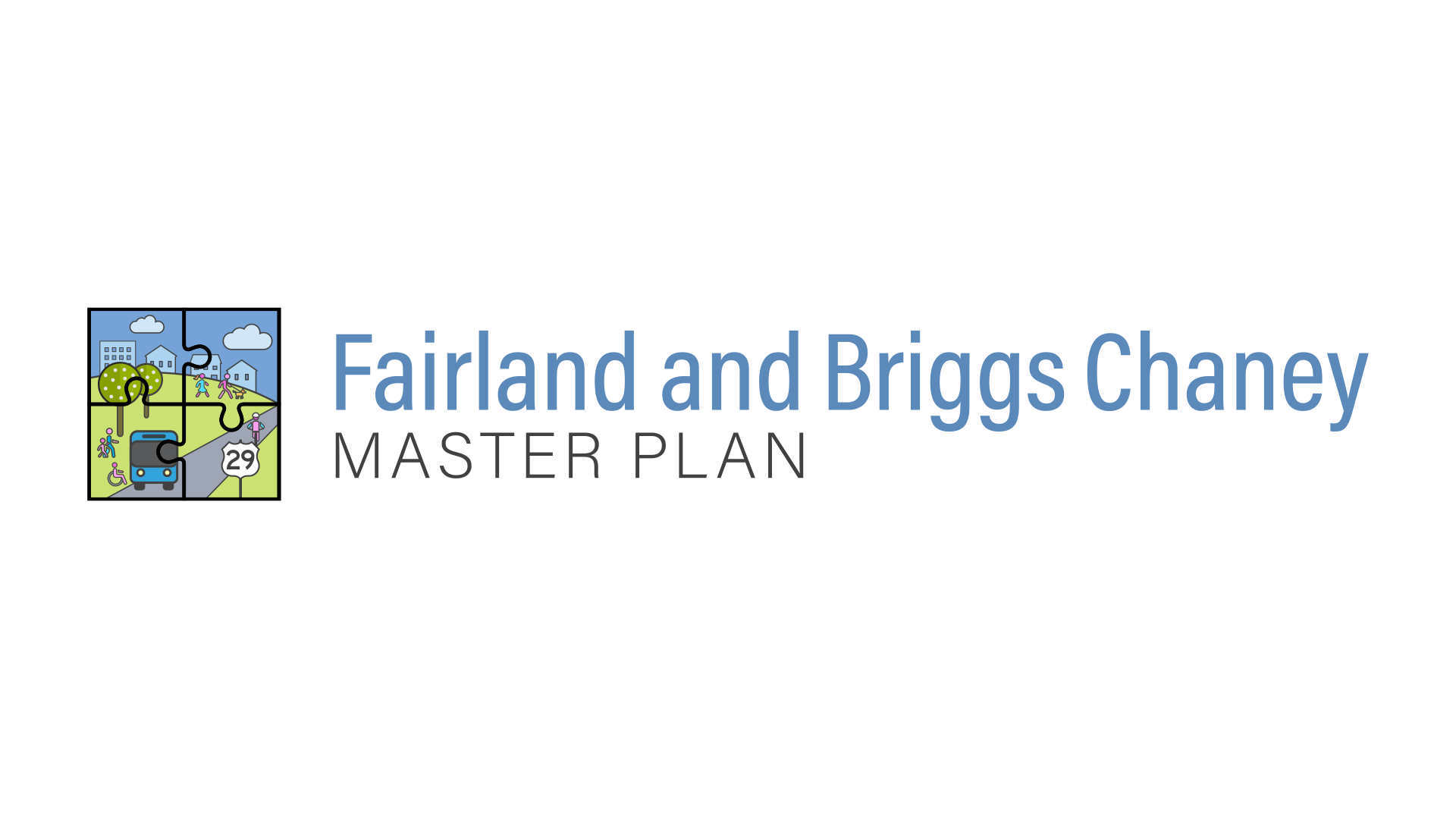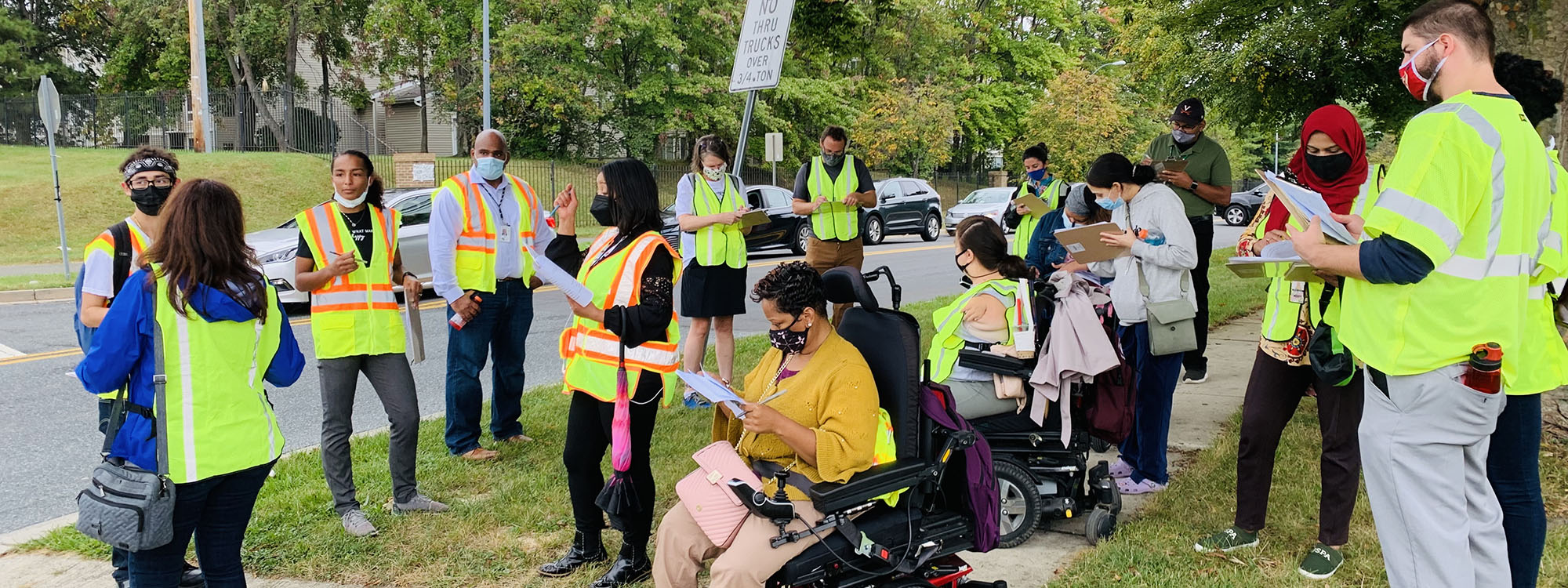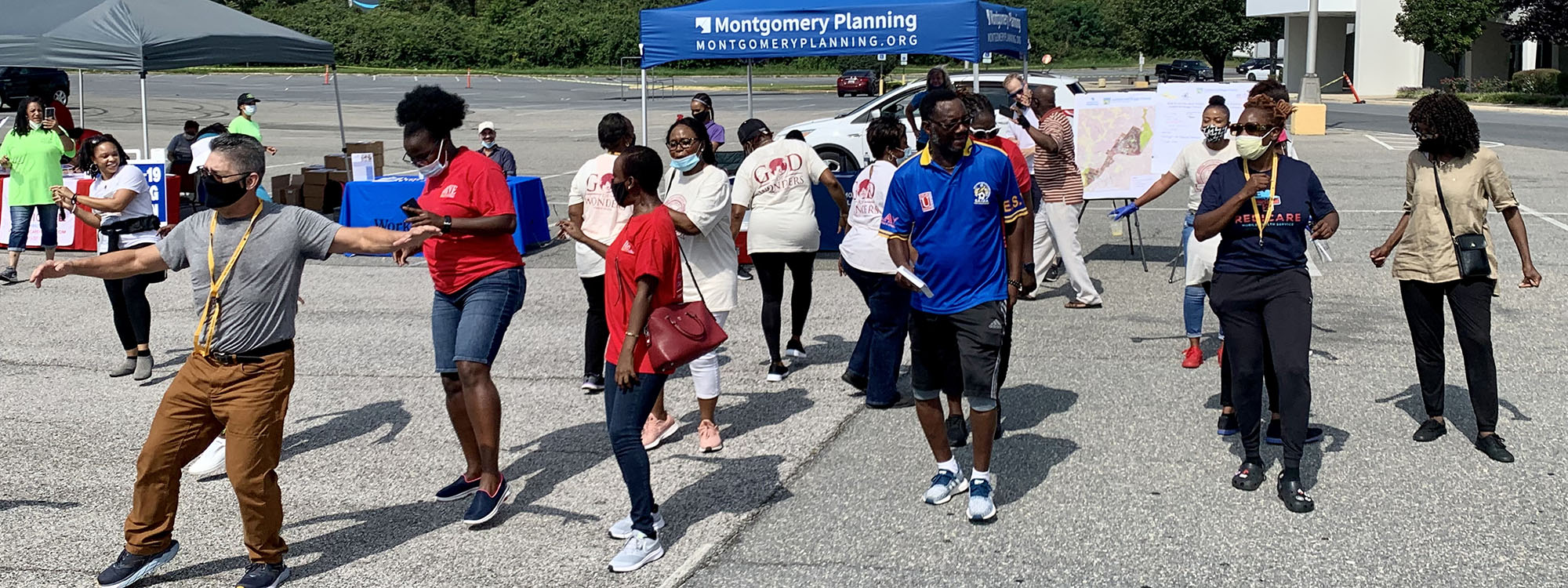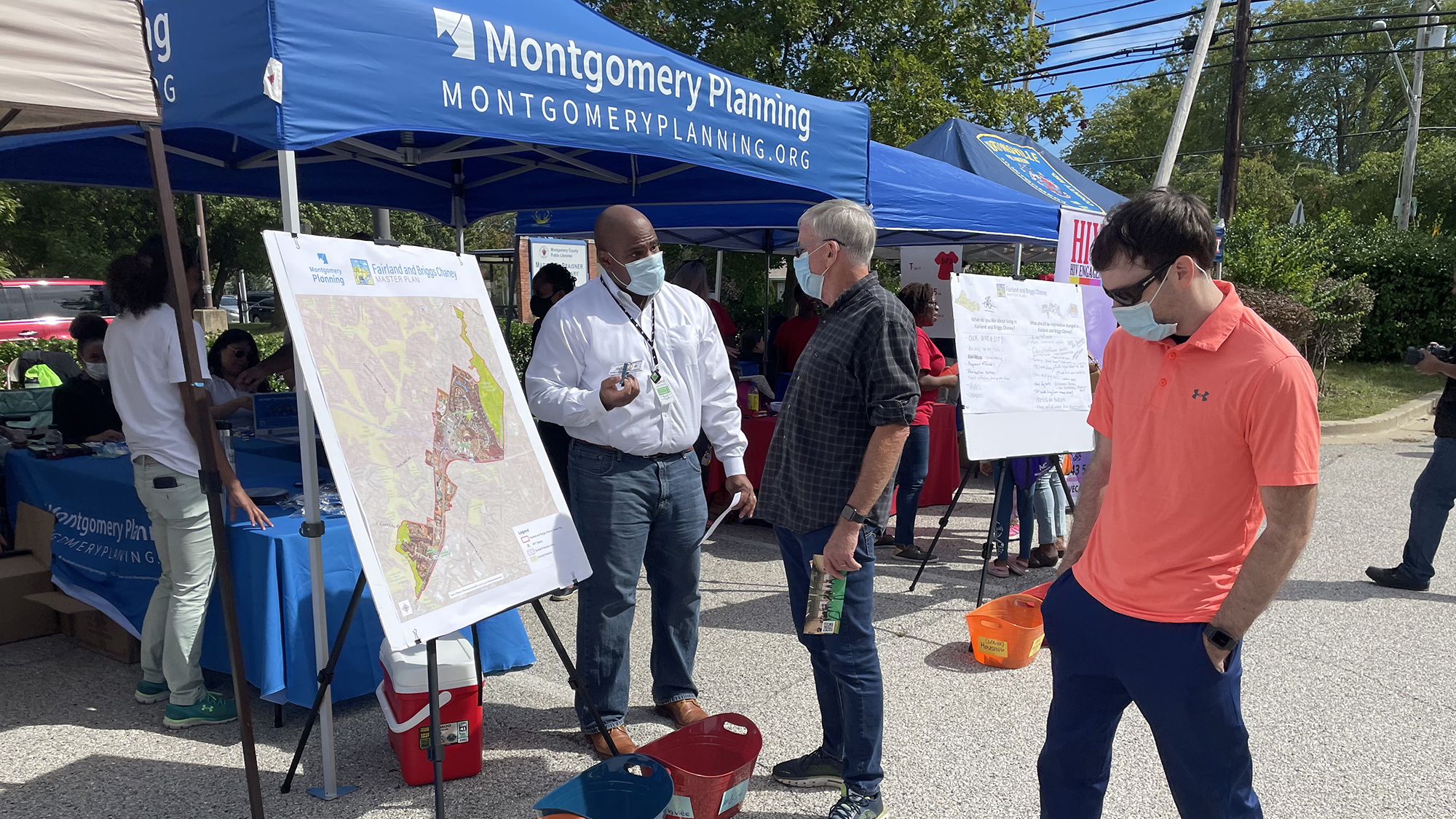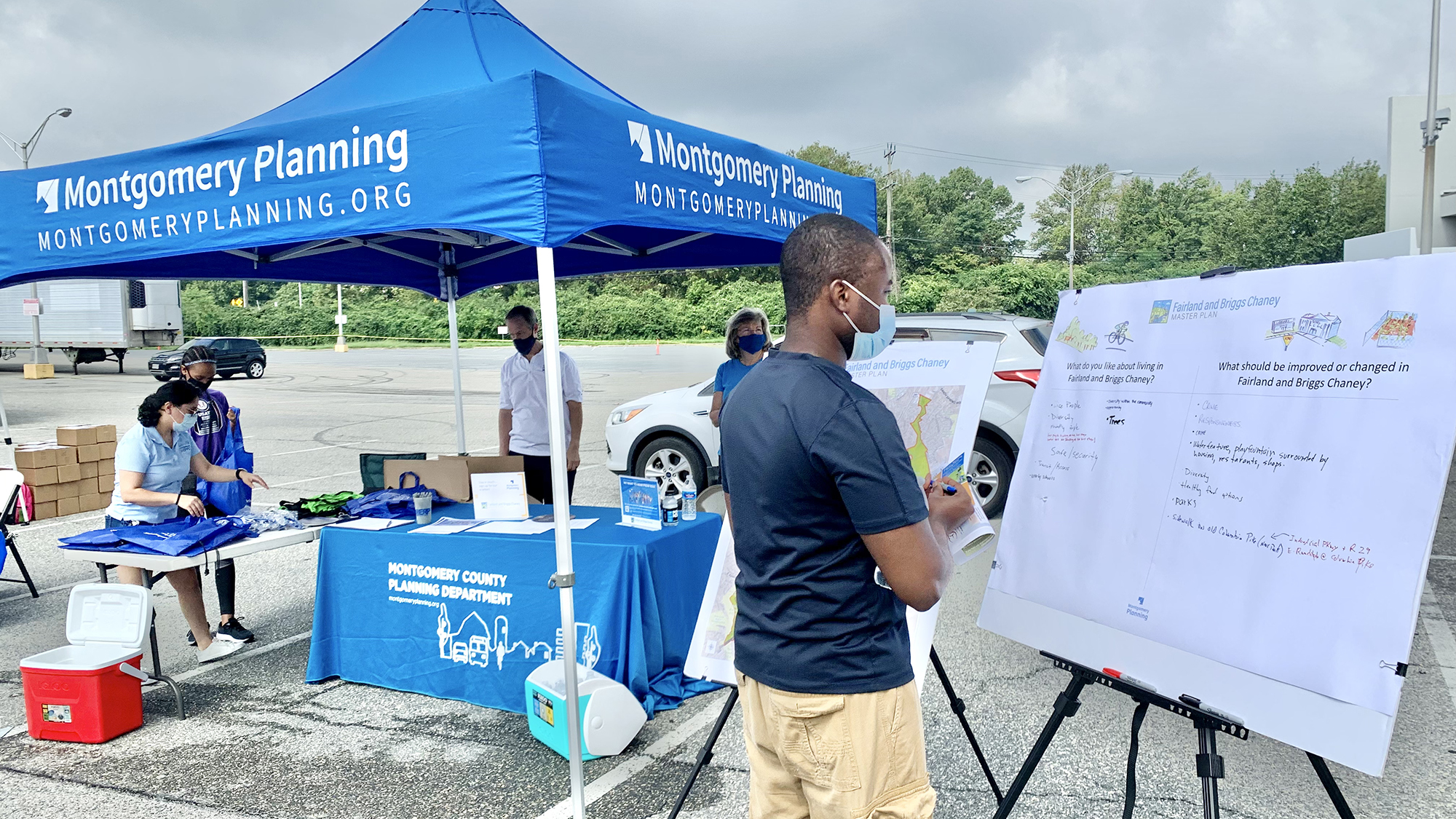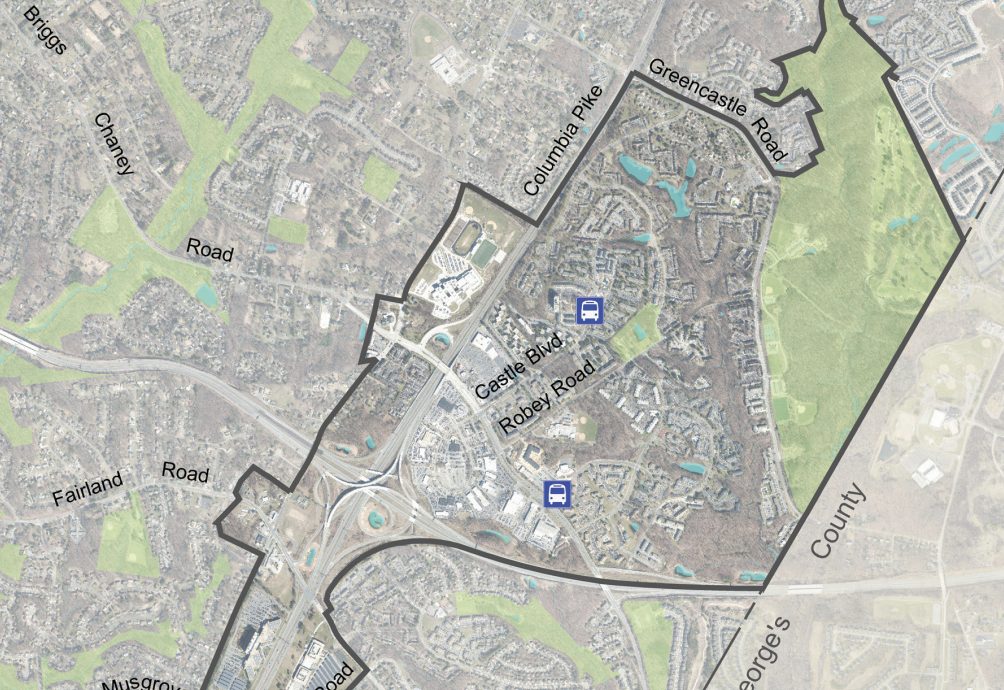The Fairland and Briggs Chaney Master Plan outlines the goals, policies and strategies to address future challenges in the Fairland and Briggs Chaney community. Not only does the plan seek to make room for growth, jobs and new residents, but it also strives to improve the quality of life for people already living here, supporting a more prosperous, equitable, and resilient community in East County.
Approved and Adopted by the M-NCPPC
The Maryland-National Capital Park and Planning Commission (M-NCPPC) voted unanimously to approve and adopt the Fairland and Briggs Chaney Master Plan at its meeting on January 17, 2024. Following adoption of the plan, the Montgomery County Planning Board and the Montgomery County Council approved a Sectional Map Amendment (SMA) to change zoning districts in the plan area per the plan’s recommendations. The County Council approved the SMA on June 18, 2024. View the updated zoning districts.
View the approved and adopted Fairland and Briggs Chaney Master Plan.
Fairland and Briggs Chaney Master Plan Implementation Advisory Committee
A major recommendation of the approved and adopted plan is the establishment of a new Implementation Advisory Committee (IAC) to help guide the plan’s community objectives and implement the plan. Committee members will be appointed by the Montgomery Planning Board and work closely with the East County Citizens Advisory Board and other organizations working for the betterment of the Fairland and Briggs Chaney community.
New members on the Fairland and Briggs Chaney IAC will be appointed by the Montgomery Planning Board on July 25, 2024, and will begin meeting to set a course for master plan implementation soon thereafter. Please check back on this webpage for future updates from the committee.
Project Timeline
-
April 2021Scope of Work
On April 8, 2021, the Fairland and Briggs Chaney Master Plan presented the Scope of Work and plan boundary map to the Planning Board. -
May to August 2021Project Kickoff
Montgomery Planning held its first virtual Spring Speakers Series focused on topics relevant to the Fairland and Briggs Chaney community and documented existing conditions for use throughout the planning process. In July and August, our partner, Everyday Canvassing, conducted interviews across the community to better understand the people, places, and stories of Fairland and Briggs Chaney. -
Fall 2021 to Spring 2022Listening Phase and Existing Conditions Analysis
Montgomery Planning conducted an extensive community engagement process of public participation and involvement that built relationships though listening and learning about the people and places that make up the community.
View recordings of the Listening Series meetings and other community engagement activities.
Read the Community Engagement Report.
The Planning team also continued to document community assets and the existing physical conditions of the plan area in anticipation of the next phases of community visioning and preparing preliminary recommendations. This included transportation infrastructure, parks, schools, housing, businesses, environmental conditions, and other features. -
Spring 2022 to Winter 2023Visioning
The planning team held a series of visioning workshops and meetings with community stakeholdersto inform development of staff’s preliminary recommendations.
Learn more about the visioning workshops and watch the recap poem video.
A Montgomery Planning-sponsored placemaking festival on October 21-22, 2022 brought to life the visions of the Fairland and Briggs Chaney Master Plan by temporarily reimagining a portion of the Briggs Chaney Park and Ride lot and testing some of the envisioned community amenities in real life.
Learn more about the Fairland and Briggs Chaney Placemaking festival held on October 21-22.
Preliminary Recommendations
Preliminary recommendations drew from hundreds of comments, conversations, ideas, and illustrations generated by visioning workshop participants and community stakeholders over the summer of 2022 to realize the general vision expressed over the course of these workshops for a more engaging, safe, and supportive community. They formed the basis for the recommendations that were included in later master plan drafts.
The planning team presented an initial set of preliminary plan recommendations to the community and Montgomery County Planning Board at two meetings in September 2022.
• Community Open House – Tuesday, September 27 at the East County Community Recreation Center (in-person meeting)
• Planning Board Briefing – Thursday, September 29 at the Wheaton HQ Auditorium. View the recorded video and download the presentation slides.
Preliminary recommendations draw from hundreds of comments, conversations, ideas, and illustrations generated by visioning workshop participants and community stakeholders this past June and July and are intended to realize the general vision expressed over the course of these workshops for a more engaging, safe, and supportive community.
A community meeting was held on January 17, from 6 to 8 p.m., at the Paint Branch High School cafeteria (14121 Old Columbia Pike, Burtonsville, MD 20866) to preview a full set of preliminary recommendations before release of the Working Draft Plan in early Spring 2023. Download the presentation slides. View the plan’s full set of Preliminary Recommendations. -
Fall 2022 to Winter 2023Refining (Working Draft)
During this phase, the planning team prepared a draft plan to incorporate community feedback to realize the shared vision for the future of the Fairland and Briggs Chaney community. At its March 23, 2023 meeting, the Planning Board added its comments and accepted the Working Draft of the plan as the Public Hearing Draft.
View the Fairland and Briggs Chaney Working Draft -
Spring 2023Sharing (Planning Board Public Hearing)
At its March 23 meeting, the Planning Board accepted the Working Draft of the plan as the Public Hearing Draft. Following the Planning Board Public Hearing held on May 4 to accept oral testimony, the public was encouraged to review and provide additional written testimony on the draft plan to the Planning Board through the close of the public record on May 19, 2023.
View the Fairland and Briggs Chaney Master Plan Public Hearing Draft .
View a recording of the Planning Board Public Hearing on May 4.
View the staff presentation slides from the May 4 Public Hearing.
View the staff report for the May 4 Public Hearing
Additional Documents for the Public Record
1997 Fairland Master Plan
Council Proposed Draft Thrive Montgomery 2050, October 2022
2013 Countywide Transit Corridors Functional Master Plan
2018 Technical Update to the Master Plan of Highways and Transitways
2018 Montgomery County Bicycle Master Plan
Fairland and Briggs Chaney Master Plan Community Engagement Report, February 2022
Fairland and Briggs Chaney Master Plan Existing Conditions Report, April 2022
Fairland and Briggs Chaney Housing Market Assessment Study, July 2022
Sharing (Planning Board Work Sessions and Planning Board Draft)
The Planning Board held two work sessions on May 18 and 25 to review public testimony and make revisions to the draft plan. They directed staff to incorporate revisions to the Public Hearing Draft and approved the Planning Board Draft for transmittal to the County Council on May 25, 2023.
View the Fairland and Briggs Chaney Master Plan Planning Board Draft
View the Fairland and Briggs Chaney Master Plan Planning Board Draft – Appendices A-Transportation Modeling Analysis, B-Community Engagement, and C-Climate Assessment Report
View a recording of the May 18 Planning Board Work Session
View the staff report for the May 18 Planning Board Work Session
View a recording of the May 25 Planning Board Work Session
View the staff report for the May 25 Planning Board Work Session.
View the May 25 staff report Attachment A: Complete Written Public Testimony
View the May 25 staff report Attachment B: Planning Board Direction from May 18 Work Session
View the May 25 staff report Attachment C: Summary Matrix of Written and Oral Testimony -
Summer to Fall 2023County Council and County Executive
During this phase, the Montgomery County Council and County Executive reviewed the approved Planning Board Draft of the Fairland and Briggs Chaney Master Plan for consideration of approval. The County Council held a public hearing on September 27, 2023 to accept public comments on the Planning Board Draft Fairland and Briggs Chaney Master Plan.
View the staff report for the September 27 Council Public Hearing
View testimony submitted to the County Council
View a recording of the September 27 Council Public Hearing
The Council’s Planning, Housing, and Parks (PHP) Committee held a series of work sessions to review public comments before recommending the plan to the Full Council with revisions.
View the staff report for the October 16 PHP Committee Work Session
View a recording of the October 16 PHP Committee Work Session
View the staff reports for the October 23 PHP Committee Work Session – Staff Report 1 and Staff Report 2
View a recording of the October 23 PHP Committee Work Session
View the staff report for the October 30 PHP Committee Work Session
View a recording of the October 30 PHP Committee Work Session
View the staff report for the November 6 PHP Committee Work Session
View a recording of the November 6 PHP Committee Work Session
After considering the PHP Committee’s recommended revisions during two work sessions, the County Council approved a resolution to adopt the plan on December 12, 2023.
View the staff report for the November 14 Council Work Session
View a recording of the November 14 Council Work Session
View the staff report for the November 28 Council Work Session
View a recording of the November 28 Council Work Session
View the staff report for the December 12 Council Meeting to approve the Fairland and Briggs Chaney Master Plan
View a recording of the December 12 Council Meeting to approve the Fairland and Briggs Chaney Master Plan
View the Interim County Council-Approved Fairland and Briggs Chaney Master Plan -
Winter 2023/2024M-NCPPC Master Plan Adoption
The council-approved master plan was transmitted back to the Planning Board and the Maryland-National Capital Park and Planning Commission (M-NCPPC) for final approval and adoption.
View the staff report for the December 21 Planning Board meeting to approve a Resolution of Adoption
View a recording of the December 21 Planning Board meeting
View the agenda packet for the January 17, 2024 Full Commission meeting – Item 4.e
View a recording of the January 17 Commission meeting -
Winter to Spring 2024Sectional Map Amendment
The Sectional Map Amendment (SMA) process is the final step in the master plan process. The SMA implements all zoning recommendations approved and adopted in the master plan. The Planning Board authorizes the SMA application submittal to the County Council. The County Council conducts a public hearing followed by work sessions, and consideration to approve zoning map changes.
The Planning Board approved the Fairland and Briggs Chaney SMA on February 29, 2024 and the Montgomery County Council approved the SMA on June 18, 2024.
View the Certified Sectional Map Amendment Map Index for the Fairland and Briggs Chaney Master Plan.
Frequently asked questions
Montgomery County’s master planning process creates a long-term vision to guide future growth and development of a community through public policy and regional planning. To build a master plan, we collect public input, host surveys, and consider existing policies, developments, physical characteristics, and social and economic conditions. Based on our analysis of these factors, the Planning Department then formulates recommendations for a community’s growth, economy, housing, transportation, community facilities, and land use.
The last master plan effort (1997 Fairland Master Plan) resulted in a number of neighborhood improvements based on community feedback, including a recreation center, local parks, and athletic fields—so it’s important for your voice to be heard! By participating in the process, you can advocate for the improvements you want to see in your neighborhood, from public spaces and parks to housing options, safety, and more.
Your opinion is a vital part of the master planning process! Regardless of your experience or qualifications, everyone knows what they like or dislike about their community—and what needs the most improvement. Participating in this planning process means your seat at the table has been reserved. However, you will need to show up and participate in conversations about the neighborhood’s priorities and goals for the future. Community members will need to bring their knowledge and experiences to the planning process such that decision-makers hear from you directly. Your help and participation will ultimately ensure that the Fairland and Briggs Chaney Master Plan reflects the whole community’s values and shared vision.
Yes, your feedback matters to this plan! Community feedback will be instrumental in building the future recommendations of the Fairland Briggs Chaney Master Plan. The strength of the plan will be guided on the comments of how residents, workers, students, worshippers, and other stakeholders live, work and play within their community. You will know that your feedback matters because as the planning team collects data, actual stories, recorded interviews, and community photos these elements may be viewed on the webpage and/or in the actual document. We encourage your participation and welcome any ideas, issues, and opportunities to help build this plan together. Stay informed and learn about how your feedback matters, sign up for our e-letters. We will notify you of any updates, news, upcoming events, and draft documents as those are made available.
A people-first or community-led approach targets engagement efforts towards the audiences that our work affects—and ideally, focuses on historically underrepresented communities within those audiences—so we can amplify often-unheard voices and build out an agenda based on residents’ lived experiences. This approach is consistent with the work of local non-profit organizations, community advocates and organizers. This strategy is used to build meaningful working partnerships with stakeholders both within the Fairland and Briggs Chaney community and beyond. Collecting a combination of analytical data and feedback, we can better interpret the hard data and better understand the stories (e.g. soft data) we collect about the neighborhood’s existing conditions. Within the context of this Master Plan, our findings and planning policy recommendations will be strongly supported by the data points and stories from the people who want to live, work and develop in the Fairland and Briggs Chaney area.
The Montgomery County Planning Department’s people-first community engagement strategy ultimately informs the professional recommendations for future generations.
Equitable engagement is one of three major themes of the Thrive Montgomery Plan 2050. Expanding on the progress made by the equity working group for the Thrive Montgomery Plan, we will continue to use the 3-pronged approach as the guiding framework for organizing our target audiences into three separate categories. The first category is based on our traditional (hierarchical) method, which allows us the opportunity to meet one-on-one with neighborhood leaders. The second category is based on a shared-power method that allows us to build working partnerships with civic groups and connect them to community advocates. The third category is based on a grassroots method which allows us the opportunity to help resolve localized problems from the ground up with the community’s support.
As we move forward, the planning team will continue to identify ways to reach all community members and make it easier for stakeholders to participate, and we encourage you to contribute at every stage of the process. The best way to stay in touch is to sign up for our e-letters so you can receive the latest news, events, and updates. You can also connect with us on Facebook, Twitter, Instagram, and more.
In accordance with Bill 27-19, incorporating a racial equity and social justice lens is requirement for all Master Plans. However, prior to the effective date of this Bill (March 2, 2020), the Thrive Montgomery Plan 2050 was well underway and emphasized “community equity” as one of three major themes. On the heels of the Thrive Montgomery Plan 2050, the Fairland and Briggs Chaney Master Plan is gaining momentum as the first corridor focused plan to fully infuse racial equity and social justice throughout the planning process. As we continue to listen to the community’s feedback, this information will be used to justify final land use recommendations.
A racial equity and social justice timeline will be prepared highlighting the impacts of previous land use practices such as redlining in an effort to learn from the past and identify ongoing legacies of historical discrimination in the community that need to be addressed. The Fairland Briggs Chaney Master Plan is also located in an Equity Focus Area. Equity Focus Areas are parts of the County that are characterized by high concentrations of certain household incomes, people of color and those who may also speak English less than very well. These communities may experience the highest inequities in access to transportation, job opportunities, environmental and recreational amenities and other resources supporting a high quality of life. The analysis of Equity Focus areas will seek to ensure that all future programs, policies, resource allocations and capital projects are done so equitably.
Currently, Route 29 is a limited access highway that moves a high volume of traffic and features a new Bus Rapid Transit route. Previous studies and Master Plans have stated Route 29 acts as a barrier between communities and had poor walkability and connections. Our re-imagining of Route 29 centers on creating a “complete community”—a fundamental goal of Thrive Montgomery 2050, the county’s newly updated General Plan. Residents that live in a complete community have access to most essential services within a relatively close distance from their homes, allowing people to meet their daily needs within a 15-minute walking radius, bike ride, or transit trip. Residents that work, shop, learn, and play in close distance from their homes experience a higher quality of life. In order to achieve that vision and a higher quality of life for the existing residents, we should encourage commercial and residential improvements along existing transportation corridors like Route 29 to help establish centers of activity for a vibrant community, while reducing both environmental impacts and sprawl growth patterns.
Route 29 has great potential to become a more transit-oriented place with safe multimodal travel options. The plan will seek ways to make transit, walking, micro mobility, and bicycling the preferred travel mode for daily trips and reduce vehicle trips (e.g. single occupancy vehicular trips). The plan will also incorporate Vision Zero principles, an action plan to eliminate transportation-related deaths and severe injuries by the year 2030 to improve safety, mobility and connectivity in the Fairland and Briggs Chaney community.
Montgomery Planning is currently developing the county’s first Pedestrian Master Plan. The purpose of the Pedestrian Master Plan is to make walking and rolling safer, more comfortable, convenient, and accessible for pedestrians of all ages and abilities throughout the county. The Planning Department is also developing a new approach to designing county roads using a concept called “Complete Streets.” Complete Streets are roadways that are designed and operated to provide safe, accessible, and healthy travel for all users, including pedestrians, bicyclists, transit riders, and motorists. The adopted Bicycle Master Plan sets forth a vision for the county as a world-class bicycling community, where everyone has access to a comfortable, safe, and fully connected bicycle network for both recreation and daily commuting. The Fair and Briggs Chaney Master Plan will examine ways to advance and implement these important transportation planning efforts.
Fairland-Briggs Chaney has a variety of businesses, from small local-serving retail outlets to a regional headquarters of a global telecommunications firm. Thus, it serves as a business center, a local marketplace, a commuting stopover, and a destination for some commercial activities—most notably the purchase of a new car. Planning staff hopes to engage with business owners to help contribute to the people-first approach to this master plan through redevelopment and possibly placemaking activities by temporarily and/or permanently converting parking lots to places. Creating the conditions for these businesses to thrive is a key goal of the plan. The plan also seeks to help cultivate new businesses that will provide needed services, jobs, and opportunities for wealth creation for residents. Finally, the plan will help guide new and existing businesses to grow in ways that support and enhance the quality of life in nearby communities and complement new infrastructure investments such as the Bus Rapid Transit line on Route 29.
Creating and preserving housing options is an integral part of the Fairland and Briggs Chaney Master Plan. Through the master planning process, staff will analyze existing conditions and make recommendations based on the anticipated future housing needs in the area. These recommendations will likely include a balance between the production and preservation of housing that recognizes the variety of housing needs of residents of Fairland Briggs Chaney– including by type, size, tenure, and affordability level.
Another key factor to consider, is the proximity of housing to the existing transportation systems. Route 29 can accommodate growth through infill and redevelopment; thereby, creating vibrant mixed-use nodes around transit stations and bus stops. Building off equity as a framework, the plan will explore ways to create opportunities for housing, commerce, placemaking, and jobs around the new BRT stations and underutilized surface parking lots to create equitable people-centric streets and connections to parks, open space, and other community assets.
Possibly! Once we have heard the input and feedback from the community about their assessment of community green spaces, we will factor this information into the conversations about necessary improvements to local parks and the development of new community green spaces.
The current Master Plan boundary contains three parks. The plan boundary area also contains several private open space areas and green spaces. The goal of the Master Plan would be to increase the amount of accessible green spaces and public amenities. The Route 29 corridor features several properties with large surface parking lots with little to no green space available for community gatherings. In this planning process, we will use the feedback gathered during engagement activities (e.g. questionnaire, listening sessions) to assess the community’s need for recreation and rank accessibility based the quality of the user’s experience. The feedback will also help guide the need for additional trail access to the larger park and open space system.
Yes, the plan will recommend necessary improvements and identify existing conditions that do not support safe access to healthy foods. The plan will also include better methods for evaluating successful outcomes to eliminate food insecurities based on “complete community” and quality of life indicators. Exacerbated by the global pandemic, food security has frequently come up as a major concern throughout the County. In response to these concerns, we will also explore existing and historical disparities in the County as a whole, supported by the Equity Emphasis Areas mapping tool. This mapping tool prioritizes areas within Montgomery County that are characterized by both high concentrations of lower-income people of color and residents that may also speak English less than very well. This mapping tool specifically identifies these areas in the county to assess potential racial and social inequities. Effectively responding to these quality of life issues is also consistent with (and critically important to) the Planning Department’s commitment to racial equity and social justice.
